Ecological Sanitation in Uganda - EcoSanRes
Ecological Sanitation in Uganda - EcoSanRes
Ecological Sanitation in Uganda - EcoSanRes
Create successful ePaper yourself
Turn your PDF publications into a flip-book with our unique Google optimized e-Paper software.
<strong>Ecological</strong> <strong>Sanitation</strong> <strong>in</strong> <strong>Uganda</strong><br />
ECOSAN:<br />
The best Approach to excreta management<br />
COMPILED BY DERRICK SSEWANYANA-NETWAS-U<br />
Over the years, two basic approaches to manag<strong>in</strong>g human excreta have<br />
existed <strong>in</strong> the world. The approach of “drop and store” which <strong>in</strong>volves<br />
conf<strong>in</strong><strong>in</strong>g faeces and ur<strong>in</strong>e a dug hole so that it is kept from the public to<br />
decompose. This is commonly seen <strong>in</strong> form of the traditional pit latr<strong>in</strong>es commonly<br />
found <strong>in</strong> many develop<strong>in</strong>g countries.<br />
The second approach is the “flush and discharge” also known as the conventional<br />
method that is common <strong>in</strong> the developed regions. It <strong>in</strong>volves flush<strong>in</strong>g the excreta<br />
away and dilut<strong>in</strong>g it <strong>in</strong> surface water bodies like rivers and lakes.<br />
These two approaches are associated with a number of issues <strong>in</strong>clud<strong>in</strong>g ground water<br />
pollution and land shortage for the construction of new pit latr<strong>in</strong>es when old ones<br />
are full. The flush and discharge system <strong>in</strong>volves the loss of large amounts of water,<br />
sometimes contam<strong>in</strong>at<strong>in</strong>g fresh water bodies. The approach is also costly <strong>in</strong> terms of<br />
high <strong>in</strong>vestments <strong>in</strong> <strong>in</strong>stallation of plumb<strong>in</strong>g and treatment of waste water systems.<br />
As a result, a lot of valuable agricultural fertilizers are lost through the use of these<br />
systems which perceive human excreta as “waste”, and are therefore not returned <strong>in</strong><br />
to the soils to close the loop. Accord<strong>in</strong>g to Stockholm Environmental Institute (2004),<br />
1 person per year looses between 400 and 500 litres of ur<strong>in</strong>e, 50 litres of faeces and<br />
about 15,000 litres of pure water that is flushed away. This amounts to the loss of<br />
7.5 kg of nitrates, phosphorus and potassium which can produce 250 kg of gra<strong>in</strong> per<br />
year.<br />
A susta<strong>in</strong>able, closed loop approach that treats human excreta as a resource is an<br />
alternative for the two approaches. The approach of <strong>Ecological</strong> sanitation (Ecosan)<br />
is based on 3 fundamental pr<strong>in</strong>ciples of; prevent<strong>in</strong>g pollution rather than attempt<strong>in</strong>g<br />
to control it, sanitiz<strong>in</strong>g ur<strong>in</strong>e and faeces and us<strong>in</strong>g the safe products for agricultural<br />
activities. It is an approach of “sanitize and recycle”. The Ecosan approach <strong>in</strong>terrupts<br />
the cycle of pathogens through sanitization of excreta by either dehydration or<br />
decomposition mechanisms. This system can be tailored to the needs of the users<br />
<strong>in</strong> modern, convenient, desirable, gender friendly and economically susta<strong>in</strong>able<br />
means. This is possible through the provision of a wide range of Ecosan toilet options<br />
with vary<strong>in</strong>g costs and tra<strong>in</strong><strong>in</strong>g up the local personnel to construct the facilities for<br />
themselves.<br />
The commonest Ecosan toilet designs <strong>in</strong>clude; Ur<strong>in</strong>e Diversion Dry Toilet (UDDT) that<br />
operates by the pr<strong>in</strong>ciple of dehydration, Fossa Alterna and the Arborloo (that operate<br />
by the pr<strong>in</strong>ciple of compost<strong>in</strong>g). The Ecosan approach is an equitable and susta<strong>in</strong>able<br />
paradigm s<strong>in</strong>ce it suitably addresses the aspects of diseases prevention by destroy<strong>in</strong>g<br />
faecal pathogens ensures environmental protection by prevent<strong>in</strong>g pollution of water<br />
sources and recycles nutrients by return<strong>in</strong>g them to the soil <strong>in</strong>form of '' humanure.’’<br />
Due to the various costs and designs available. It is affordable as well as culturally<br />
and aesthetically acceptable and yet simple to ma<strong>in</strong>ta<strong>in</strong> <strong>in</strong> terms of technical capacity,<br />
<strong>in</strong>stitutional frame work and technical resources.<br />
I n s p i r a t i o n a l s u c c e s s s t o r i e s<br />
9


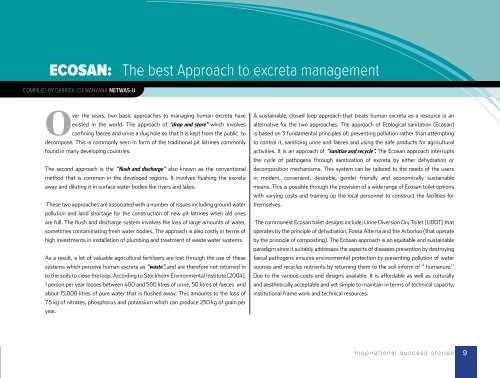
![Project Document [PDF: 2.31 MB] - EcoSanRes](https://img.yumpu.com/51279385/1/184x260/project-document-pdf-231-mb-ecosanres.jpg?quality=85)

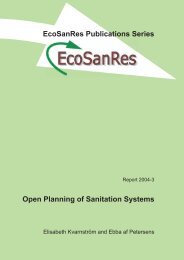

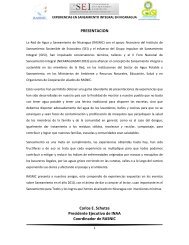
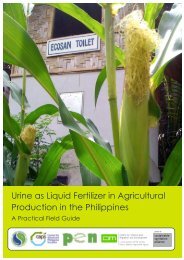

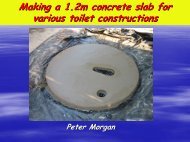



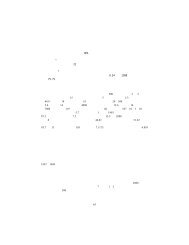
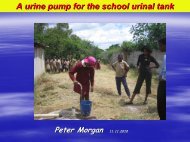
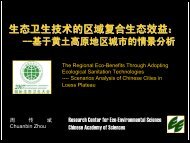
![Latrines à compost [high-resolution colour PDF: 12.3MB] - EcoSanRes](https://img.yumpu.com/31726141/1/185x260/latrines-a-compost-high-resolution-colour-pdf-123mb-ecosanres.jpg?quality=85)